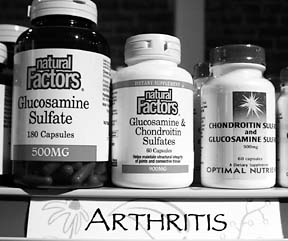We’ve noticed something interesting: Any time we mention a remedy for arthritis, we are almost immediately inundated with calls and letters and e-mail and faxes from dozens of readers, all of them desperate to procure the magic substance. Is arthritis becoming more prevalent in the canine world? Or are dogs (like humans) simply living longer than they used to – long enough to suffer the disease, which is more common in older animals.
We don’t have an answer to those questions, but fortunately, we do know of a fairly new type of supplement that is showing great promise for relieving – and, in some cases, reversing – the arthritic process. The supplements are known collectively as glycosaminoglycans, “GAGs” for short. The best-known GAGs are chondroitin sulfate and glucosamine.
Like so many other nutritional supplements, the substances we’re discussing have enjoyed a meteoric rise to fame in recent years. That’s both good news and bad news – good news, because great numbers of people (and dogs!) have been helped by the substances; and bad news, because the market is now rife with a confusing array of products containing the substances in any number of formulations and concentrations, some helpful, and some quite doubtful.

A Different Approach to Treating Arthritis in Older Dogs
Osteoarthritis occurs when the cartilage that cushions the ends of bone joints breaks down, causing joint pain, inflammation, pain, and deformity. Until development of the GAGs, most substances aimed at osteoarthritis relief have been some form of pain killer and/or anti-inflammatory.

The GAGs tackle the problem from an entirely different angle. Rather than simply dulling the pain that results from the arthritis, or reducing the fluid buildup (inflammation) that follows joint trauma, GAGs are chemical reproductions of substances found in the body. These substances are not yet fully understood, but because they are present in cartilage, researchers speculated that supplemental doses of the substances might help slow or stop destruction of cartilage caused by arthritis.
The hunch has paid off; the substances do seem to help the body repair cartilage damage, and lessen pain from osteoarthritis, though scientists are still unclear on the exact chemical mechanism responsible for the benefits. Glucosamine is thought to stimulate the formation of new cartilage and help repair damaged cartilage. Chondroitin seems to draw beneficial fluid into cartilage, restoring lost resistance and elasticity, and slowing cartilage breakdown by protecting it from destructive enzymes.
The substances are most often extracted from animal sources; glucosamine usually comes from crab, lobster, or shrimp shells, and chondroitin is most often made from cartilage (usually cattle tracheas, but sometimes shark cartilage is used).
Ordering GAGs for Your Dog
As with all supplements, it pays to learn as much about all the permutations of a product as possible. Smart consumers read the product labels carefully, to determine how much they are paying for what amount of the active ingredients. Careful comparisons yield all sorts of devious (or, at the very least, enigmatic) descriptions of bottle contents.
Take, for instance, the well-known product called “InflamAway,” which contains glucosamine, as well as yucca and garlic. Several dog-product catalogs suggest feeding a dog “one 1500 mg. wafer per 40 pounds of body weight.” Does this mean the dog will be receiving 1500 milligrams of beneficial glucosamine? Well, no. A call to the sellers of the product reveals that one wafer of the “Regular strength” version contains 100 milligrams of glucosamine; the “Super strength” contains 500 mg.
Another product, “Joint Jolt,” is described by its maker as an “all-in-one combination that supplements and supports the joint capsules, ligaments, and tendons,” and contains herbs, chondroitin sulfate, antioxidants, enzymes, amino acids, and “a number of other nutrients.” How much chondroitin sulfate will a dog receive from one dose of Joint Jolt? We don’t know! The catalog didn’t say, and when we called the maker, we were told they couldn’t tell us! Only 200 mg. of chondroitin sulfate are present in one “2,000 mg. tablet” of “Fresh Factors,” a multi-nutrient supplement sold by Springtime, Inc. The catalog does not say the tablets contain 2,000 mg. of chondroitin but then why do they list the weight of a multiple-ingredient tablet at all, if not to lead a consumer to think that the number of milligrams listed is the number of milligrams of active ingredient?
We just can’t help but be suspicious of a company that makes you work hard to figure out what you’re getting for your money. Our warning bells go off when we see products like “GP Flex,” sold by KV Vet Supply Co., a catalog retailer located in David City, Nebraska. The catalog says one 12-ounce bottle of the stuff sells for $10.90. It also says that each ounce in the bottle contains 2,500 mg. of chondroitin sulfate powder. So what the heck are you supposed to do if you want to give your dog 500 mg. of chondroitin sulfate?
What to Look for in a GAG
Our suggestions are simple: First, if you want to try giving your arthritic dog a GAG supplement, look for products that contain nothing but the substance you want. A shotgun-approach to supplementation might work in some cases, but you’ll never know what substance it was that proved to be helpful. Better to try a single-substance product (or a combination of the two high-profiles GAGs, glucosamine and chondroitin sulfate).
Second, choose a supplement that comes in a package that clearly states exactly how much of each substance is present in each dose. We’ll guarantee you that these products won’t have cute names, but you’ll know what you’re getting. For instance, a product called “Glucosamine Sulfate 500” will contain 500 milligrams of glucosamine sulfate per capsule. Yahoo! Something labeled “Glucosamine 500 & Chondroitin 400” contains, you guessed it, 500 mg. of glucosamine and 400 mg. of chondroitin sulfate per tablet.
Other good sources for pure, clearly described GAG products? We also like Drs. Foster & Smith’s “Joint Care,” which adds vitamin C (but nothing else!) to its formula of glucosamine and chondroitin sulfate. The “Regular” capsules contain 500 mg. glucosamine HCI, 400 mg. chondroitin sulfate, and 50 mg. Vitamin C. “Mini” capsules contain 500 mg. glucosamine HCI, 100 mg. chondroitin sulfate, and 1.5 mg. Vitamin C.
Health food stores and natural remedy catalogs can also be good sources. We appreciated the straightforward approach taken by Bronson Vitamins and Herbals, a catalog retailer located in American Fork, Utah. They, too, sell pure chondroitin sulfate capsules (500 mg.), glucosamine sulfate tablets (600 mg.), and a combination product containing 10 mg. glucosamine sulfate, 665 mg. glucosamine HCI, and 100 mg. chondroitin.
More on GAGs
Because these supplements are sold as “dietary supplements,” rather than as medicines, they are not regulated by the Food and Drug Administration. According to an article published in the September/October 1998 issue of Arthritis Today (published by the nonprofit Arthritis Foundation), lab analysis found far lower levels of the active ingredients in some GAG products than were alleged on the labels. Natalie Eddington, Ph.D., a pharmacist and researcher who has analyzed dozens of GAG products, suggests that consumers buy products made by larger, reputable companies that can be held accountable for any discrepancies that might be discovered.
Glucosamine is commonly offered in one of two forms: hydrocloride (HCI) and as a sulfate. Experts say both forms seem to be performing equally well. But some forms of chondroitin seem to be far better than others. Eddington and other experts suggest avoiding the chondroitin products made from shark cartilage, as these products tend to be less consistent in quality.
Cautions for Use
In the last few years, far more humans than dogs have been serving as “guinea pigs” for testing the efficacy of these substances, so far more human doctors than veterinarians are familiar with them. That’s why people who are considering giving GAGs to their dogs would be well-advised to observe cautions suggested by the Arthritis Foundation for human use.
The Foundation’s first suggestion is to discuss the planned administration of these products with the patient’s doctor, especially if the patient takes regular medications.
Because glucosamine is an amino sugar, and can raise a subject’s blood sugar levels, people (and dogs) with diabetes ought to avoid this supplement. Subjects who take any blood-thinning medications or daily aspirin (and many people give their dogs aspirin to ease arthritis pain) should not take chondroitin, which can thin the blood further.
While no long-term studies have yet been conducted on these substances, the anecdotal evidence is quickly amassing. As we continue to tabulate our readers’ responses to our request for firsthand experiences with GAGs, we’ll select some of their comments to be published in an upcoming issue. For now, suffice to say that every one of the testimonials sent in by WDJ readers have praised the ability of some GAG supplement to ease their dogs’ arthritic symptoms.






